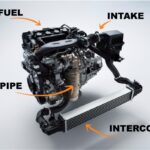A common misconception about using waste oil as fuel is that it produces a smoky, dirty flame. This is only true with poorly designed burners. This article details the journey of building a Homemade Used Oil Furnace, perfect for melting large quantities of metal, even iron (excluding cupola furnaces). This fuel-efficient and environmentally friendly method offers a cost-effective solution for hobby foundry enthusiasts.
Why Choose a Waste Oil Furnace?
For hobbyists melting large amounts of metal, especially iron, oil offers significant economic advantages over other fuels. Waste oil, often free and readily available, can be a sustainable and cost-effective fuel source. With proper burner design, clean and efficient combustion is achievable. This guide focuses on building a homemade used oil furnace, highlighting design considerations and safety precautions.
Designing and Constructing the Furnace
The initial design involved a self-contained unit encompassing the furnace, burner assembly, and fuel tank, all mounted on a wheeled frame for mobility. The framework was constructed using steel water pipes and rebar, welded together.
A crucial component is the blower, responsible for providing the necessary airflow for combustion. A custom blower was built using cast aluminum housings and a repurposed motor from a home heating system oil burner.
Several burner designs were experimented with, evolving from a two-piece “Hot Momma” Ursutz derived design (G1) to a more compact and efficient one-piece G2 version. Further refinements led to the G4 burner, featuring an intake manifold for enhanced air/oil mixing.
Fuel Considerations: Waste Oil Options
Both used motor oil and vegetable oil can be used. Vegetable oil, considered carbon neutral, is a cleaner-burning option, minimizing the risk of toxins or heavy metals.
Storage solutions included using repurposed propane tanks for fuel tanks, ensuring safety by filling them with water during welding to prevent explosions. A dipstick gauge was added for monitoring fuel levels.
Safety Precautions
Working with hot oil and open flames necessitates strict adherence to safety measures. Never use water to extinguish an oil fire; use dry sand or dirt instead. The information provided here is based on personal experience and should be used cautiously. Always prioritize safety and consult relevant resources for comprehensive safety guidelines.
Conclusion
Building a homemade used oil furnace is a viable option for hobby metalcasting. Careful design, construction, and adherence to safety protocols are paramount for successful and safe operation. This approach not only provides a cost-effective solution for melting metal but also contributes to recycling waste oil. Remember, burning waste oil cleanly for heat recovery is a form of recycling, according to the EPA. This project demonstrates the potential of transforming waste into a valuable resource.
